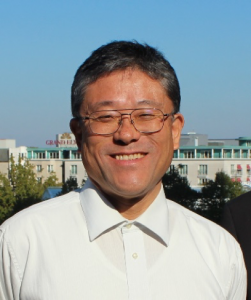
Prof. Satoshi Tadokoro
Human-Robot Informatics Laboratory
Tohoku University, Japan
Personal webpage
Title of presentation: Disaster Robotics [Monday 12 September 2016 / 09:20 - 10:20]
Abstract: The Great Eastern Japan Earthquake was the first disaster where many robotic systems were used for disaster response and recovery. It is predicted that robotic systems become essential solutions in the near future. In this speech, special topics related to disaster robots and systems will be introduced.
Brief Bio:
Satoshi Tadokoro graduated from the University of Tokyo in 1984. He became an Associate Professor of Kobe University in 1993-2005, and is a Professor of Tohoku University since 2005, Vice Dean in 2014, and Research Professor since 2014. He is a president of International Rescue System Institute since 2002 and IEEE RAS President in 2016-2017.
He served as a project manager of MEXT DDT Project on rescue robotics in 2002-2007 having contribution of more than 100 professors nationwide, and of a NEDO project that developed a rescue robot Quince, which was used in nuclear reactor buildings of the Fukushima-Daiichi Nuclear Power Plant Accident as the first Japanese robot. He is a project manager of Japan Cabinet Office ImPACT Project in 2014-18. IEEE Fellow, RSJ Fellow, JSME Fellow, and SICE Fellow.

Gianmarco Veruggio
Operational Unit of Genoa of CNR-IEIIT
Istituto di Elettronica e di Ingegneria dell'Informazione e delle Telecomunicazioni
CNR-IEIIT, Genova, Italia
Personal webpage
Title of presentation: Roboethics - Focus on Drones [Tuesday 13 September 2016 / 09:00 - 10:00]
Abstract: The presentation, after an introduction on Roboethics, outlines the new issues posed by the increasing spread of the use of drones beyond the scope of their traditional employments for research and military aims. The Speaker explains why new and updated regulatory rules are needed because of the widespread use of drone consumer market. Furthermore, ethical, legal and societal aspects (ELSA) of employment of drones should be deeply discussed due to the massive use of drones in the so called “war on terror”. Actually, most of these issues arise from the military origin of the UAV (Unmanned Aerial Vehicle). But also their civilian use poses important problems of safety, privacy, anonymity and secrecy.
Brief Bio:
He is Director of Research at Italian National Research Council and Responsible for the Genoa Branch of IEIIT, the Institute of Electronics, Computer and Telecommunication Engineering.
He founded the CNR Robotlab (1990-2003) with the aim to develop experimental robotics. His research interests encompass control system architectures for Internet robotics, human-robot interaction and educational robotics. He led the first Italian underwater robotics campaigns in Antarctica during the Italian expeditions in 1993, 1997 and 2001, and the first Italian underwater robotics campaign in Arctic during 2002.
In 2000 he founded the association “School of Robotics” to promote this new science among young people and the society at large by means of educational robotics. In 2002 he coined the word, and proposed the concept of Roboethics. He was the General Chair of the “First International Symposium on Roboethics” in 2004 and of the “EURON Roboethics Atelier” in 2006 that produced the Roboethics Roadmap. For his merits in the field of science and society, in 2009 he was awarded the title of Commander of the Order to the Merit of the Italian Republic.

Prof. Seth Hutchinson
Dept. of Electrical and Computer Engineering
University of Illinois, USA
Personal webpage
Title of presentation and outline: Design, Modeling and Control of a Biologically-Inspired Bat Robot [Tuesday 13 September 2016 / 14:00 - 15:00]
Abstract: In this talk, I will describe our recent progress building a biologically-inspired bat robot. Bats have a complex skeletal morphology, with both ball-and-socket and revolute joints that interconnect the bones and muscles to create a musculoskeletal system with over 40 degrees of freedom, some of which are passive. Replicating this biological system in a small, lightweight, low-power air vehicle is not only infeasible, but also undesirable; trajectory planning and control for such a system would be intractable, precluding any possibility for synthesizing complex agile maneuvers, or for real-time control. Thus, our goal is to design a robot whose kinematic structure is topologically much simpler than a bat's, while still providing the ability to mimic the bat-wing morphology during flapping flight, and to find optimal trajectories that exploit the natural system dynamics, enabling effective controller design.
The kinematic design of our robot is driven by motion capture experiments using live bats. In particular, we use principal component analysis to capture the essential bat-wing shape information, and solve a nonlinear optimization problem to determine the optimal kinematic parameters for a simplified parallel kinematic wing structure. We then derive the Lagrangian dynamic equations for this system, including inertial and aerodynamic forces. We use a shooting-based optimizer to locate physically feasible, periodic solutions to this system, and an event-based control scheme is then derived in order to track the desired trajectory. We demonstrate our results with flight experiments on our robotic bat.
Brief Bio:
Seth Hutchinson received his Ph.D. from Purdue University in 1988. In 1990 he joined the faculty at the University of Illinois in Urbana-Champaign, where he is currently a Professor in the Department of Electrical and Computer Engineering, the Coordinated Science Laboratory, and the Beckman Institute for Advanced Science and Technology. He served as Associate Department Head of ECE from 2001 to 2007. He currently serves on the editorial boards of the International Journal of Robotics Research and the Journal of Intelligent Service Robotics, and chairs the steering committee of the IEEE Robotics and Automation Letters. He was Founding Editor-in-Chief of the IEEE Robotics and Automation Society's Conference Editorial Board (2006-2008), and Editor-in-Chief of the IEEE Transaction on Robotics (2008-2013). He has published more than 200 papers on the topics of robotics and computer vision, and is coauthor of the books "Principles of Robot Motion: Theory, Algorithms, and Implementations," published by MIT Press, and "Robot Modeling and Control," published by Wiley. Hutchinson is a Fellow of the IEEE.

Prof. Jian S. Dai
Chair of Mechanisms and Robotics
School of Natural and Mathematical Sciences
King’s College London, University of London, UK
Personal webpage
Title of presentation: Kinematics That Entails Reconfigurable Mechanisms [Wednesday 14 September 2016 / 09:00 - 10:00]
Abstract: This talk presents the study of kinematics and screw theories and their relations to Lie groups and Lie algebra through finite screws and is to be followed by the kinematics entailed reconfigurable mechanisms and robots. The intrinsic theory in the kinematics study provides a foundation of development of reconfigurable mechanisms and robots in their various forms, leading to a two-decade innovation in metamorphic mechanisms, reconfigurable robots and evolutionary parallel robots. With change of order of a screw system, the mechanism changes its mobility and presents its different topologies. Extensive applications of the reconfigurable mechanisms and robots are to be presented in the aspects of assembly, packaging, food industry, domestic robots, walking robots, and medical robots, with the current state of the art of reconfigurable mechanisms and robots.
Brief Bio:
Professor Jian S. Dai is a world leader and founder in developing a field of research and practice in reconfigurable mechanisms. He coined and advocated the idea of reconfigurable mechanisms as a promising concept to bridge the gap between versatile but expensive robots, and efficient but non-flexible machines. In his 26 years of study of screw theory, Prof. Dai established himself as an international leading figure in the field of theoretical kinematics particularly in screw theory from his work on finite twists in early 1990s to the continuing publications on screw systems and screw algebra in the last twenty years, leading to a recently published book entitled “Geometrical Foundation and Screw Algebra of Mechanisms and Robotics” in Chinese translated from the English original that is to be published.
Prof. Dai received the 2015 ASME Mechanisms and Robotics Award in Boston, and is the 27th recipient of this prestigious lifelong-contribution award established in 1974 as in Wikipedia.
Prof. Dai is also the recipient of several conference and journal paper awards, ASME/IEEE outstanding service award, 2010 King’s College London Overall Supervisory Excellence Award, and 2012 Mechanisms Innovation Award from the China mechanisms committee. He is a Fellow of the ASME and IMechE, and has published over 400 works including four books.
Rodolphe Gelin
EVP Chief Scientific Officer at Aldebaran
Personal webpage
Title of presentation: Designing for interaction in social robotics [Wednesday 14 September 2016 / 13:40 - 14:05]
Abstract: Since 2005, SoftBank Robotics (previously known as Aldebaran), develops companion humanoid robots. The humanoid shape has been chosen because it creates spontaneously a desire of communication. As soon as people meet NAO or Pepper, they start to talk and interact with them. As it turns out, the social acceptability of our robots relies on their humanoid shape. In this presentation, we will describe the benefits but also the risks of this choice of design that does not only concern the physical appearance but also the general behaviour of the robot.
Brief Bio:
Rodolphe Gelin (1965) started his career at CEA (French Atomic Energy Commission), he has been working there for 10 years on mobile robots control for industrial applications and on rehabilitation robotics. Then he had been in charge of different teams working on robotics, virtual reality and cognitics. From 2006 to 2008, he was in charge of business development for Interactive System Program. He has participated to the European Coordinated Action CARE that supports the ETP EUROP on robotics in charge of the robotic roadmap for the European Community. In 2009, he joined Aldebaran Robotics as head of collaborative projects. He is the leader of the French project ROMEO that aims to develop a human size humanoid robot. Since 2016, he is Chief Scientific Officer at Aldebaran Robotics.
Prof. Gurvinder Singh Virk
Professor of Robotics,
University of Gävle and KTH Royal Institute of Technology,
Stockholm, SWEDEN
Personal webpage
Title of presentation: International standardisation and robot ethics [Wednesday 14 September 2016 / 14:05 - 14:30]
Abstract: The current trend in robotics is to develop new markets in service and medical sectors. This is leading primarily to safety concerns since the close human-robot interactions needed in the new scenarios cannot be provided because traditional industrial robots have been designed and operated using the “separate the robot from the human” philosophy. The concerns led to new ISO/IEC robot standardization initiatives to formulate new safety requirements so that close human-robot interaction could be facilitated without causing harm. The new robots are also leading to a variety of concerns related to ethics and legal issues and these remain largely unaddressed. Ensuring safety is a primary role of regulation and international safety standards support this overall process. The talk will present an overview of the ISO/IEC activities in the personal care and medical robot sectors and explore how standardisation could address wider issues of robot ethics via consensus agreements reached at international level with all stakeholders involved.
Brief Bio:
Professor Gurvinder S. Virk (BSc, PhD, DIC, FIET, FCIBSE, CEng, CMath, FIMA, MIEEE). Prof Virk is Professor of Robotics at University of Gävle, Gävle and KTH Royal Institute of Technology, Stockholm, Sweden. He is also Trustee of the UK registered charity CLAWAR aimed at advancing robotics for the public benefit. Prior to moving to Sweden in March 2011, he was at Massey University, Wellington, New Zealand and before that at University of Leeds, UK.
He is a technical expert in control theory and its applications with particular experience in service robotics and the use of advanced model-based control to a variety of applications. His current interests are in physical assistant exoskeletons for elderly persons (medical and non-medical applications). He has extensive experience of project management, leading international R&D and standardisation projects and he has held several grants from national and European sources (total value of over €20m), as well as industry. He has produced over 350 papers in these areas and 11 books, 16 PhDs successfully completed. Prof Virk is Convenor of three international robot standardisation work groups, namely:
- ISO TC299/ WG02: Personal care robot safety,
- IEC TC62/SC62A & ISO TC299 JWG9: Medical electrical equipment and systems using robotic technology (medical robots)
- ISO TC299/WG06: Modularity for service robots
who are developing the important standards for the new emerging robots. He is also Coordinator of the euRobotics Topic Group on Robot Standardisation which is providing the inputs for robot standardisation related issues into the EC Horizon 2020 Programme.
He is Fellow of the Institution of Engineering and Technology (FIET) and Fellow of the Chartered Institution of Building Services Engineers (FCIBSE) and a Fellow of the Institute of Mathematics and its Applications (FIMA); he is a Chartered Engineer and a Chartered Mathematician. He has been awarded, the Freedom of the City of London for his work in promoting Information Technology and is a Freeman of the Worshipful Company of Information Technology.








